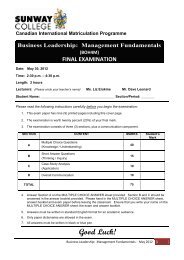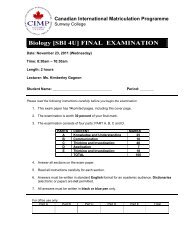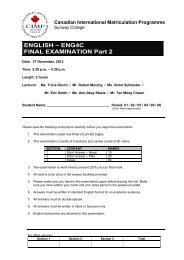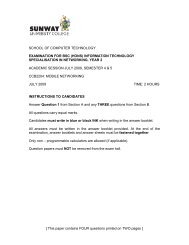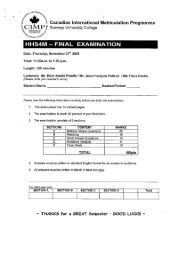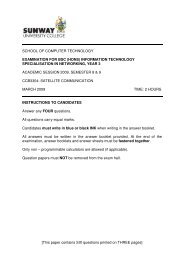Question Booklet
Question Booklet
Question Booklet
Create successful ePaper yourself
Turn your PDF publications into a flip-book with our unique Google optimized e-Paper software.
Final Exam November 2005<br />
Section I: Multiple Choice - 20 marks<br />
Select the best answer for the following multiple choice questions below. Then write the<br />
answer clearly on the line next to the answer. Make sure you mark it very clearly. Select<br />
the best answer.<br />
_____ 1. What statement below is the best definition of opportunity cost?<br />
a. The resources that are used to produce a particular good to satisfy one want<br />
instead of another.<br />
b. The cost of one good compared to that of another.<br />
c. The satisfaction we gain from choosing one good instead of another.<br />
d. The cost of all that is lost from choosing one good or action instead of another.<br />
_____ 2. Which of the following is the best example of a positive or analytical<br />
statement?<br />
a. The unemployment rate declined for two months in Indonesia by more than 0.5%.<br />
b. An unemployment rate of more than 7% should be acceptable to the government.<br />
c. A change in government will surely cause the unemployment rate to fall.<br />
d. A high unemployment rate is unacceptable to most people.<br />
_____ 3. In a command economy, who or what decides what will be produced?<br />
a. The people decide through their elected representatives.<br />
b. The managers of state enterprises and factories decide.<br />
c. The needs and wants of people “decide” what will be produced.<br />
d. The central planners decide based upon the priorities of the nation.<br />
_____ 4. What does Adam Smith’s theory of the “invisible hand” mean?<br />
a. In a competitive environment, business prosperity in the economy by pursuing<br />
profits for themselves.<br />
b. Government is the invisible hand, promoting economic welfare.<br />
c. Consumers are the invisible hand, directing production within the market<br />
economy.<br />
d. Monopolies impose and invisible hand, reducing competition between producers.




